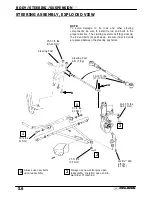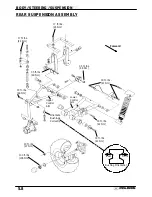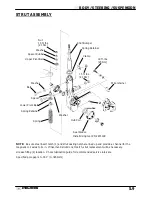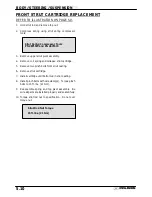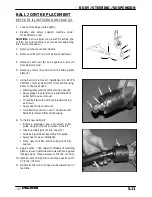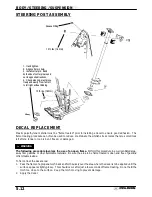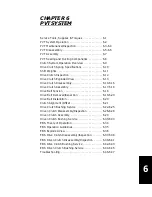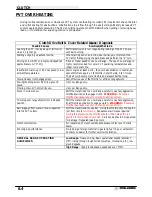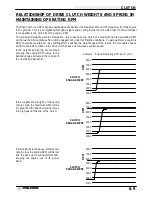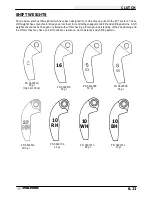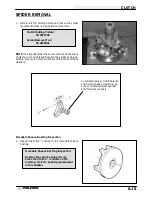
CLUTCH
6.4
PVT OVERHEATING
During routine maintenance or whenever PVT system overheating is evident, it’s important to check the inlet
and outlet ducting for obstructions. Obstructions to air flow through the ducts will significantly increase PVT
system operating temperatures. The ATV should be operated in LOW RANGE when pulling or plowing heavy
loads, or if extended low speed operation is anticipated.
Clutch Drive Belt & Cover Related Issues: Diagnosis
Possible Causes
Solutions/What to do
Loading the ATV into a pickup or tall trailer
when in high range.
Shift transmission to low range during loading of the ATV to pre-
vent belt burning.
Starting out going up a steep incline.
When starting out on an incline, use low range, or dismount the
ATV after first applying the park brake and perform the “K” turn.
Driving at low RPM or low ground speed (at
approximately 3--7 MPH).
Drive at higher speed or use Low Range. The use of Low Range is
highly recommended for cooler PVT operating temperatures and
longer component life.
Insufficient warm--up of ATVs exposed to low
ambient temperatures.
Warm engine at least 5 min., then with transmission in neutral, ad-
vance throttle to approx. 1/8 throttle in short bursts, 5 to 7 times.
The belt will become more flexible and prevent belt burning.
Slow and easy clutch engagement.
Fast, effective use of the throttle for efficient engagement.
Towing/Pushing at low RPM/low ground
speed.
Use Low Range only.
Plowing snow, dirt, etc./utility use.
Use Low Range only.
Stuck in mud or snow.
Shift the transmission to Low Range, carefully use fast, aggressive
throttle application to engage clutch.
WARNING: Excessive
throttle may cause loss of control and vehicle overturn.
Climbing over large objects from a stopped
position.
Shift the transmission to Low Range, carefully use fast, aggressive,
brief throttle application to engage clutch.
WARNING: Excessive
throttle may cause loss of control and vehicle overturn.
Belt slippage from water or snow ingestion
into the PVT system.
Shift the transmission to neutral. Using the throttle, vary the engine
rpm from idle to
full throttle
. Repeat several times as required.
During this procedure, the throttle should not be held at the full
position for more than 10 seconds.
Clutch seals should be inspected
for damage if repeated leaking occurs.
Clutch malfunction.
For inspection of clutch components, please contact your Polaris
dealer.
Poor engine performance.
Fouled plugs, foreign material in gas tank, fuel lines, or carburetor.
Contact you dealer for further service information.
GENERAL RANGE OPERATION
GUIDELINES:
Low Range: Heavy pulling, basic operational speeds less than 7
MPH, riding through rough terrain (swamps, mountains, etc.), low
ground speeds.
High Range: High ground speeds, speeds above 7 MPH.
Содержание Sportsman 400
Страница 5: ...SPORTSMAN 400 A01CH42AB SPORTSMAN 400 A01CH42AA GENERAL INFORMATION 1 3 MODEL COLOR IDENTIFICATION ...
Страница 6: ...SPORTSMAN 400 A01CH42AC GENERAL INFORMATION 1 4 MODEL COLOR IDENTIFICATION ...
Страница 21: ...Newton Meter to Pound Foot and Pound Inch GENERAL INFORMATION 1 19 TORQUE CONVERSIONS ...
Страница 22: ...Newton Meter to Pound Foot and Pound Inch GENERAL INFORMATION 1 20 TORQUE CONVERSIONS ...
Страница 94: ...ENGINE 3 25 CYLINDER HEAD EXPLODED VIEW 1 Remove the two 6mm flange bolts A from cylinder head A ...
Страница 152: ...Forward FUEL SYSTEM CARBURETION 4 2 FUEL TANK ASSEMBLY ...
Страница 325: ...BRAKES 9 22 FRONT BRAKE CALIPER EXPLODED VIEW Pads Caliper Mount Piston Pin Boot Square O Rings Adjuster Screw ...
Страница 366: ...ELECTRONIC SPEEDOMETER WIRING DIAGRAM ELECTRICAL 10 32 ...
Страница 372: ...ELECTRICAL 10 38 NOTES ...
Страница 379: ...ELECTRICAL 10 39 WIRING DIAGRAM 2001 SPORTSMAN 400 ...
Страница 380: ...ELECTRICAL 10 40 WIRING DIAGRAM 2001 SPORTSMAN 500 EARLY ...
Страница 381: ...ELECTRICAL 10 41 WIRING DIAGRAM 2001 SPORTSMAN 500 LATE ...




